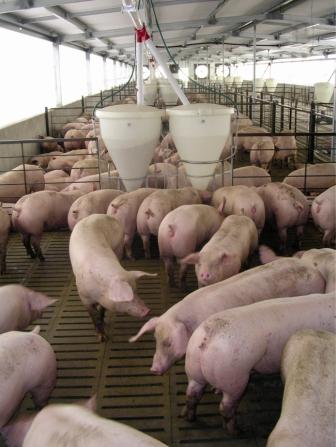Advantages of Pelleted Swine Grow-Finish Feed
Posted: July 24, 2015 | Written By: Simon Kern, M.S., Form-A-Feed Swine Nutritional Services

Pellet mills and pelleted feeds have been around since the early 1930’s when the company that would eventually become California Pellet Mill (CPM) created their first 30 horsepower mill. While pelleting feed may not be a new concept, pelleted feeds continue to expand into more segments of livestock production. Most swine producers are accustomed to feeding pelleted feed to nursery pigs for at least one diet phase, however there has been increasing interest in pelleting feed for growing and finishing feed as well. While this process certainly comes at a cost (typically $5-10 per ton), there are multiple ways in which pelleting will provide an excellent return on investment.
First of all, pelleting allows for the use of certain ingredients which cannot be used in mash feeds or must be used at a limited inclusion rate due to flowability issues. Many of these ingredients can be an excellent value and includes bakery meal, poultry by-product meal, breakfast cereal fines, and wheat red dog to name a few. Compressing these sometimes troublesome ingredients into a pellet alleviates many of the handling problems associated with them. The overall flowability of properly pelleted feeds (regardless of ingredient inclusions), is also superior to mash feeds. This reduces the likelihood of feed-out events resulting in consistent intakes and less morbidity and mortality due to digestive upsets.
Many research and field trials have also demonstrated an improvement in feed conversion with pelleted feeds versus mash feeds. This improvement is due to several factors attributed to pelleted feeds. The corn used for pelleted feed is typically ground finer than the corn included in mash feed (300-400 micron vs. 500-600 micron) and thus has an increased surface area. Additionally, the steam exposure which is part of the normal pelleting process gelatinizes and initiates the breakdown of the starch in corn (other ingredients as well). These two factors allow for more complete digestion and enhanced utilization of the nutrients in feed. Lastly, properly pelleted feeds have been shown to have reduced feed wastage when compared to mash feeds when correct feeder adjustments are made in a timely manner. Increasing feed digestion and utilization while reducing feed waste can net a substantial improvement in feed conversion.
Trials with pelleted feeds have shown improvements in feed conversion of up to 8%! While this type of improvement should not be expected in all situations, a very modest improvement in feed conversion of only 2-3% will more than pay for the cost of pelleting given current ingredient prices. When coupled with the harder to measure benefits from reduced feed-out events, the decision of whether or not to take a hard look at pelleting grow-finish feed becomes a no-brainer.
Look forward to future blogs about how high quality pelleted feeds are formulated. Please contact your Form-A-Feed swine representative or the Form-A-Feed website for more information on pelleting your grow-finish feed.